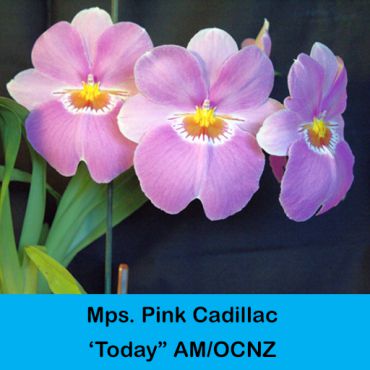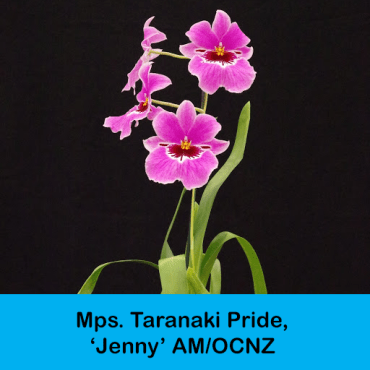When is a Fertiliser not a Fertiliser?
A personal perspective by Allan Watson
Some will say that any product that provides plants nutrients should always be called a fertiliser. I have found, in my view, that’s not the case.
The awarded plants below are from Allan's collection.



To explain my thinking
Just adding lime, Epsom salts or Blood and Bone is not adding fertiliser. You are simply adding a nutrient or vitamin to the plant to generate an action within the growth cycle.
In my view, a fertiliser needs to have measurable Nitrogen, Potassium and Phosphorus (N. P. K.) values. Not being a scientist nor having the instruments, I tend to take guidance that the levels provided on the product package are correct.
There are many products out there, but finding the right one for you and your plants may take time. After several years of experimentation, I have settled on Dyna Gro GROW 7-9-5 for my orchid collection of 1 000 plants of mixed genus. The answer is quite simple. From all the other fertilisers I tried, I was getting the same result, so the opportunity to change and the reasons behind that change have produced positive results.
A mentor who has since passed away explained to me the importance of the “CF” measurement in relation to orchids. CF is an abbreviation for Conductivity Factor, which is a measure of the dissolved salts in a given solution. Fertilisers are a combination of various salts.
In this instance, a measure of the fertiliser being delivered to the orchids during any feeding and watering session.
I found that without a stable N. P. K. in the fertiliser, the CF measurement was all over the place. In some cases, it was either too weak with little to no value to the orchids, and in other instances, it was too strong, causing root or leaf damage.
So why Dyna Gro GROW 7-9-5? After considerable reading and a two-year trial, the positive results became quite apparent. In fact they were evident within 3 months of starting to use this product.
- Plant quality improved to the extent that award-winning plants started to appear in my collection.
- Flower size increased, and the opportunity to have a degree of control as to when the plant should flower became a bit easier.
One of the key advantages of the Dyna Gro GROW 7-9-5 was that, as a grower, I did not need to change the product to induce flowering. All that was required was an adjustment to the “CF.”
Basic Orchid Health 101
Just a simple recap. I have found it interesting, to say the least, as to the number of growers that have lost sight of the meaning behind NPK.
•Nitrogen (N)
Component of proteins, hormones, chlorophyll, vitamins and enzymes. It promotes stem and leaf growth. It is also a component of the chlorophyll molecule. Nitrogen, therefore, has an influence on the green colour of plants and the rate of photosynthesis. Photosynthesis is the process whereby plants use energy from the sun, water, and carbon dioxide to form simple sugars. These simple sugars are used to build cell structures, i.e. growth.
Phosphorus (P)
Essential for seed germination, photosynthesis, protein formation, overall growth and metabolism, flower and fruit formation.
Potassium (K)
Essential for the formation of sugars, carbohydrates, proteins, cell division. Adjusts water balance; improves stem rigidity and cold hardiness; enhances flavour, colour and oil content of fruits; important for leafy crops.
Getting the Best out of Dyna Gro GROW 7-9-5
Dyna Gro GROW 7-9-5 provided me with the required balance of nutrients for my Orchid Culture, supplying 16 of the 20 essential nutrients required for optimal growth, in the correct proportions.
The nutrient program I use is as follows:
- Using a conductivity meter and at the dosage rate of 10ml per 10L I get a “CF” reading of 4 (0.4 mS/cm2).
- About a month out from when I would like the spikes to appear, I increase the “CF” reading to 6 (0.6 mS/cm2) simply by increasing the dose rate by 10%.
- About a month out from flowering, I increase the dose by a further 10% to 15%, so I get a “CF” reading of 8 (0.8 mS/cm2).
- Once flowered, I revert back to the standard dose rate of CF 4 (0.4 mS/cm2).

My Results
As is often said, a picture speaks a thousand words.
This picture is Miltoniopsis (Mps.) Robert Jackson “Wild Thing”. This picture has been staged as it shows two plants side by side. These plants were in reality, side by side in the same growing environment. The flower on the right is of an Mps. that was just fed an off-the-shelf bargain fertiliser and produced a flower around 60mm in iameter. The Flower on the Left was feed Dyna Gro GROW 7-9-5 in the controlled process mentioned previously.
This result was repeated several times to confirm but in my mind seemed a no-brainer.
The change to Dyna Gro GROW 7-9-5 was indeed a no-brainer. My entire orchid Collection is now being fed with this product. Below is a sample of the same result with a number of Miltoniopsis. I am more than happy to endorse Dyna Gro’s products.
Bio of this grower
Allan Watson has been growing and hybridising orchids of and on for 20 years. His passion of late has been growing and hybridising the Miltoniopsis genus. Allan has won several awards for his plants, a testament to his skill at growing orchids.
Allan is a member of the Taranaki Orchid Society and a founding member of NZ Odontoglossum Alliance Growers.
